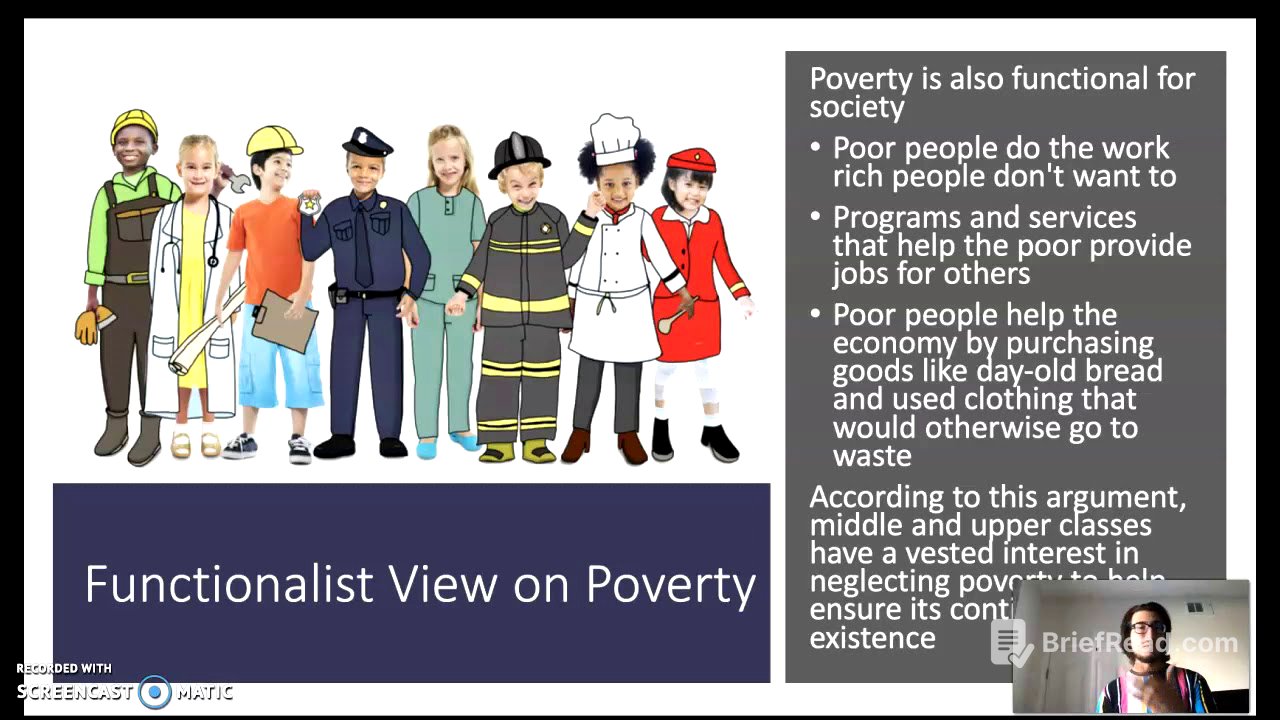TLDR;
This video discusses poverty in the United States, debunking myths about poor people being lazy or wanting to take advantage of the system. It presents statistics on the demographics of poverty, sociological explanations from functionalist, conflict theory, and symbolic interactionist perspectives, and highlights structural barriers that prevent individuals from escaping poverty.
- Poverty is a complex issue with structural factors that prevent opportunity for certain individuals.
- Functionalism argues that stratification and poverty are inevitable and even functional for society, while conflict theory attributes stratification to a lack of opportunity and discrimination.
- Symbolic interactionism examines how the labeling of certain groups as poor affects how others view and interact with them.
Introduction: Debunking Myths About Poverty [0:00]
The video starts by addressing the common myths surrounding poverty, particularly the idea that poor people are simply lazy or trying to exploit the welfare system. It challenges the notion that anyone can overcome poverty through hard work alone, a concept often associated with the American Dream. The existence of "welfare queens" is also debunked as an exaggerated stereotype with little basis in reality.
Poverty Statistics in the United States [1:39]
The video presents statistics to illustrate the scope of poverty in the U.S. Over 46 million people live below the poverty line, with a significant portion being children under 18 and adults over 65. Among those of working age (18-64), over 9 million are already employed but not earning a living wage, and another 3.5 million are unemployed but actively seeking work. Additionally, millions are disabled or serving in the armed forces. The data reveals that the vast majority of poor people are either unable to work, already working, or actively seeking employment, highlighting the structural barriers that prevent them from escaping poverty.
Sociological Explanations of Poverty: Functionalism [5:41]
The video explores sociological explanations of poverty, starting with functionalism. Functionalism suggests that stratification exists because it is functional and inevitable for society. It argues that some jobs are more important and require more skill, thus deserving higher incomes to incentivize individuals to pursue them. From this perspective, poverty is also functional, as poor people perform jobs that others don't want to do and contribute to the economy through the purchase of discounted goods. However, the video critiques this perspective, questioning who decides which jobs are "important" and highlighting the lack of equal opportunity in society.
Sociological Explanations of Poverty: Conflict Theory [9:57]
The video then presents conflict theory as a more useful perspective for understanding poverty. Conflict theorists argue that stratification results from a lack of opportunity, discrimination, and prejudice against the poor, women, and people of color. They believe that poverty is neither necessary nor inevitable and that those in power exploit their position to maintain their status, even if it means oppressing others. Conflict theory emphasizes the structural barriers that prevent individuals from achieving upward social mobility, such as homelessness, lack of access to education, and the burden of dependents.
Sociological Explanations of Poverty: Symbolic Interactionism [11:55]
Finally, the video examines poverty through the lens of symbolic interactionism. Unlike functionalist and conflict theories, symbolic interactionism focuses on how people assign meanings to things and how the labeling of certain groups as poor affects how others view and interact with them. It explores the impact of these labels on people's lifestyles and interactions within society.
